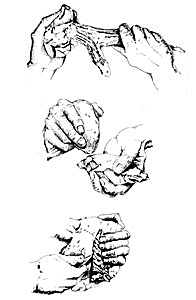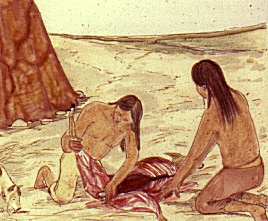Technologie d'outils
Ce texte a été publié en anglais et n'est pas disponible en français.
With his stone knife, an experienced hunter could skin a small animal with as much speed and dexterity as if he were using steel. But early Albertans had no steel. No iron, nor bronze. They had wood, leather, antler, bone and stone to use as raw materials but stone, almost exclusively, was the foundation of tool and weapons technology for Albertans for most of human history. And what early Albertans could do with material seemingly so intractable is a marvel of ingenuity.
 The principal goal of the toolmaker was - always - the pursuit and creation of an improved cutting edge. The more efficiently the animals that formed the first peoples' basic diet could be killed and processed, the more secure life was. This need for sharper edges and more efficient tools drove advances in technology, influenced the direction of the nomadic seasonal round and initiated the development of effective trade routes to procure and distribute quality stone. And wherever trade routes grew, ideas and innovation flowed along with goods.
The principal goal of the toolmaker was - always - the pursuit and creation of an improved cutting edge. The more efficiently the animals that formed the first peoples' basic diet could be killed and processed, the more secure life was. This need for sharper edges and more efficient tools drove advances in technology, influenced the direction of the nomadic seasonal round and initiated the development of effective trade routes to procure and distribute quality stone. And wherever trade routes grew, ideas and innovation flowed along with goods.
The most eagerly sought stone was extremely hard and fine-grained with the virtue of fracturing into sharp-edged flakes when struck or chiseled with another instrument. Imagine the pieces of a shattered glass window. Glass has the same properties
as the flint, obsidian, chert and  quartzite that were the preferred materials of Alberta's first toolmakers. While flint
and obsidian has to be obtained through trade networks from North Dakota, Montana or British Columbia, chert and quartzite could be found along river beds in Alberta or quarried in such places as the Crowsnest Pass.
quartzite that were the preferred materials of Alberta's first toolmakers. While flint
and obsidian has to be obtained through trade networks from North Dakota, Montana or British Columbia, chert and quartzite could be found along river beds in Alberta or quarried in such places as the Crowsnest Pass.
The most basic method of working the stone - precision flaking - was to employ a hammerstone, a hand-sized rock, to chip off large, rough flakes for simple tools. This crude method, which produced rough, ridged  surfaces and serrated edges, was usedby our human forebears in the Old World for thousands upon thousands of years. But by the time the ancestors of today's
native peoples moved into the New World between 10,000 and 20,000 years ago techniques of stone working had advanced considerably. A softer hammer, usually of bone or antler, would be used to more gently strike selected flakes of stone, reducing the coarse or
jagged edges to smaller serrations, giving a straighter, more uniform cutting edge. Then pressure flaking might be applied, particularly for more elaborate tools such as spearpoints or arrowheads. In this method, short pointed instruments of bone,
antler or even wood would push or pry tiny flakes off the edges of the tool for the sharpest edge of all. This most advanced technique required dexterity and strength but it gave the toolmaker the greatest control in shaping an instrument.
surfaces and serrated edges, was usedby our human forebears in the Old World for thousands upon thousands of years. But by the time the ancestors of today's
native peoples moved into the New World between 10,000 and 20,000 years ago techniques of stone working had advanced considerably. A softer hammer, usually of bone or antler, would be used to more gently strike selected flakes of stone, reducing the coarse or
jagged edges to smaller serrations, giving a straighter, more uniform cutting edge. Then pressure flaking might be applied, particularly for more elaborate tools such as spearpoints or arrowheads. In this method, short pointed instruments of bone,
antler or even wood would push or pry tiny flakes off the edges of the tool for the sharpest edge of all. This most advanced technique required dexterity and strength but it gave the toolmaker the greatest control in shaping an instrument.
Stone was fashioned into many tools. Scrapers, shafted to a wood or antler handle, removed hair, fat or flesh from hides before tanning. Adzes and axes worked wood. Drills bore holes in softer stone or bone. Hammers or mauls broke bones and crushed berries or dried meat for pemmican. Knives had a dozen purposes. But the most vital stone tools for the first Albertans, the ones demanding the finest craftsmanship, were weapons.
The earliest identifiable people to arrive in Alberta, in the wake of the last glaciation 11,000 years ago, used heavy wooden spears tipped with large stone points (see Stories in the Stone, page 71). These points were hafted or attached to a notch or socket at the end of the shaft and bound firmly in place with leather sinews and an adhesive substance, such as pitch. Though spears seem an elementary technology in theory, in practice several criteria had to be met, lest the weapon prove ineffectual and put the hunter at risk. The spearpoint had to be sufficiently sharp to pierce the animal's hide and wide enough to let the point reach the vital organs. The binding on the shaft had to be secure but couldn't be wider than the spearpoint or the hunter wouldn't be able to drive the weapon into the animal.
 The spear was a staff weapon used mainly for thrusting at animals, particularly mammoths and bison already lured into traps, and thus at close range. As a throwing weapon, however, the spear's range was limited to the maximum power of a human arm.
Between 8,000 and 7,500 years ago, however, a technological innovation arrived in Alberta that increased the effective range of the spear - the spear-thrower or atlatl, its Aztec name. The atlatl was essentially an extension of the spear shaft, a shaped piece bone, horn or wood with a handle at one end and a hook, hollow or groove at the other end that grasped the butt end of the spear. The hunter would hold the handle, then thrust the atlatl forward in a whip-like action so that the spear detached and hurled ahead. Because the atlatl multiplied the length and power of the hunter's throw, the weapon was much more deadly than the simple spear. Large animals could be brought down at greater distances. Spearpoints (or darts as atlatl points are called) could decrease in size without losing their lethal effect.
The spear was a staff weapon used mainly for thrusting at animals, particularly mammoths and bison already lured into traps, and thus at close range. As a throwing weapon, however, the spear's range was limited to the maximum power of a human arm.
Between 8,000 and 7,500 years ago, however, a technological innovation arrived in Alberta that increased the effective range of the spear - the spear-thrower or atlatl, its Aztec name. The atlatl was essentially an extension of the spear shaft, a shaped piece bone, horn or wood with a handle at one end and a hook, hollow or groove at the other end that grasped the butt end of the spear. The hunter would hold the handle, then thrust the atlatl forward in a whip-like action so that the spear detached and hurled ahead. Because the atlatl multiplied the length and power of the hunter's throw, the weapon was much more deadly than the simple spear. Large animals could be brought down at greater distances. Spearpoints (or darts as atlatl points are called) could decrease in size without losing their lethal effect.
Like the spear, the atlatl was most efficiently used in open areas from a stationary launching point. About 2,000 years ago, though, there was a great leap forward with the advent of the bow and arrow. Portable and flexible, it was a weapon without parallel for plains hunters. When the bowstring was pulled, it stored the gradually expended energy of the hunter's muscles, only to release this energy in a sudden burst to give the arrow a velocity much greater than possible from a spear or an atlatl. The bow and arrow also permitted superior accuracy, a longer range and rapid fire. Because short shafts for arrows are easier to find  than long shafts for spears or darts, more arrows could be produced in a shorter time. Bundles of light arrows could be carried on the hunt with ease. Aim could be taken standing or kneeling. An ambush could be accomplished with great stealth. And the points used on the lighter shafts were necessarily smaller than dart points.
than long shafts for spears or darts, more arrows could be produced in a shorter time. Bundles of light arrows could be carried on the hunt with ease. Aim could be taken standing or kneeling. An ambush could be accomplished with great stealth. And the points used on the lighter shafts were necessarily smaller than dart points.
The first bows were long - sometimes as long as a man is tall - but until the advent of the horse culture on the North American plains in the 18th century required a smaller version, there was nothing to match the proficiency of the long bow.
Reprinted from Barbara Huck and Doug Whiteway's In Search of Ancient Alberta with kind permission from Heartland Associates, Inc.







